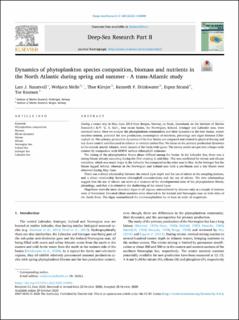| dc.description.abstract | During a return trip in May–June 2013 from Bergen, Norway, to Nuuk, Greenland, on the Institute of Marine Research's R/V “G. O. Sars”, four ocean basins, the Norwegian, Iceland, Irminger and Labrador seas, were surveyed twice. Here we analyse the phytoplankton communities and their dynamics in the four basins, winter nutrient content, potential for new production, consumption of nutrients, phenology and algae biomass (Chlorophyll a). The primary production dynamics of the four basins are compared and related to physical forcing and top-down control and discussed in relation to vertical carbon flux. We focus on the primary production dynamics in the central, mostly Atlantic, water masses of the basin-wide gyres. The survey results are put into a larger scale context by comparison with MODIS surface chlorophyll estimates.
The timing of the phytoplankton bloom phase differed among the basins. In the Labrador Sea, there was a strong bloom already occurring during the first crossing in mid-May. This was confirmed by nitrate and silicate reduction, which was much larger in the Labrador Sea compared to the other seas in May. In the Irminger Sea the bloom lagged behind, whereas in the Norwegian and Iceland seas both a pre-bloom and a late bloom were observed during May–June.
There was a direct relationship between the mixed layer depth and the use of nitrate at the sampling stations, and a direct relationship between chlorophyll concentrations and the use of nitrate. The two relationships suggest that the use of nitrate can serve as a measure of the developmental state of the phytoplankton bloom, phenology, and that it is related to the shallowing of the mixed layer.
Flagellates were the most abundant algae in all regions, outnumbered by diatoms only at a couple of stations west of Greenland. Elevated ciliate numbers were observed in the Iceland and Norwegian seas on both sides of the Arctic front. The algae outnumbered the microzooplankton by at least an order of magnitude. | en_US |
